
Figure 5-6: Siganus fish
The siganus fish is small, about 10 to 15 centimeters long, and looks much like a small tuna. It has venomous spines in its dorsal and ventral fins. These spines can inflict painful stings.
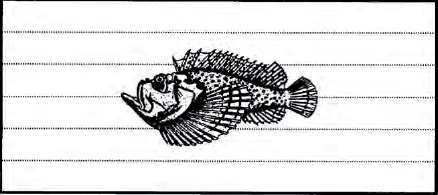
Figure 5-7: Stonefish (Synanceja species)
Stonefish are found in the tropical waters of the Pacific and Indian oceans. Averaging about 30 centimeters in length, their subdued colors and lumpy shape provide them with exceptional camouflage. When stepped on, the fins in the dorsal spine inflict an extremely painful and sometimes fatal wound.
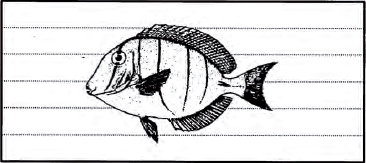
Figure 5-8: Tang or surgeonfish (Acanthuridae species)
Tang or surgeonfish average 20 to 25 centimeters in length, with a deep body, small mouth, and bright coloration. They have scalpellike spines on the side of the tail that cause fatal and extremely painful wounds including infection, envenomation, and blood loss.
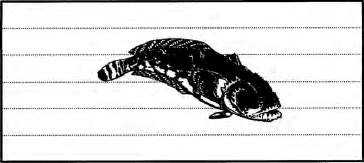
Figure 5-9: Toadfish (Batrachoidiae species)
Toadfish are found in the tropical waters of the Gulf Coast of the United States and along both coasts of South and Central America They are between 17.5 and 25 centimeters long and have a dull color and large mouths. They bury themselves in the sand and may be easily stepped on. They have very sharp, extremely poisonous spines on the dorsal fin (back).
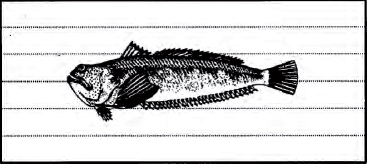
Figure 5-10: Weever fish (Trachinidae species)
The weever fish is a tropical fish that is fairly slim and about 30 centimeters long. Its gills and all fins have venomous spines that cause a painful wound. They are found off the coasts of Europe, Africa, and the Mediterranean.
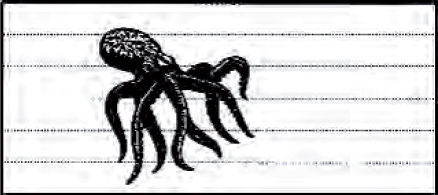
Figure 5-11: Blue-ringed octopus (Hapalochlaenalunulata)
This small octopus is usually found on the Great Barrier Reef off eastern Australia. It is grayish-white with iridescent blue ringlike markings. This octopus usually will not bite unless stepped on or handled. Its bite is extremely poisonous and frequently lethal.

Figure 5-12: Portuguese man-of-war (Physalis species)
Although it resembles a jellyfish, the Portuguese man-of-war is actually a colony of sea animals. Mainly found in tropical regions, the Gulf Stream current can carry it as far as Europe. It is also found as far south as Australia. The pink or purple floating portion of the man-of-war may be as small as 15 centimeters, but the tentacles can reach 12 meters in length. These tentacles inflict a painful and incapacitating sting, but the sting is rarely fatal. Avoid the tentacles of any jellyfish, even if washed up on the beach and apparently dead.
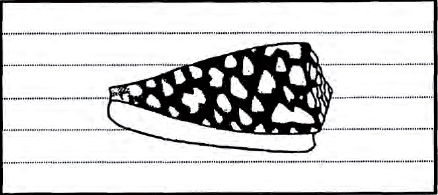
Figure 5-13: Cone shells (Conidae species)
These cone-shaped shells have smooth, colorful mottling and long, narrow openings in the base of the shell. They live under rocks, in crevices or coral reefs, and along rocky shore of protected bays in tropical areas. All have tiny teeth that are similar to hypodermic needles. They can inject an extremely poisonous venom that acts very swiftly, causing acute pain, swelling, paralysis, blindness, and possible death within hours. Avoid handling all cone shells.
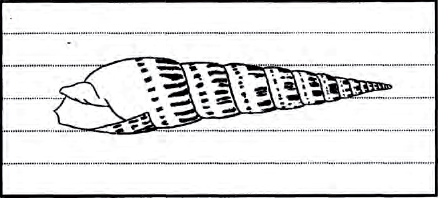
Figure 5-14: Terebra shells or Auger shells (Terebridae species)
These shells are found in both temperate and tropical waters. They are similar to cone shells but much thinner and longer. They poison in the same way as cone shells, but the venom is slightly less poisonous.
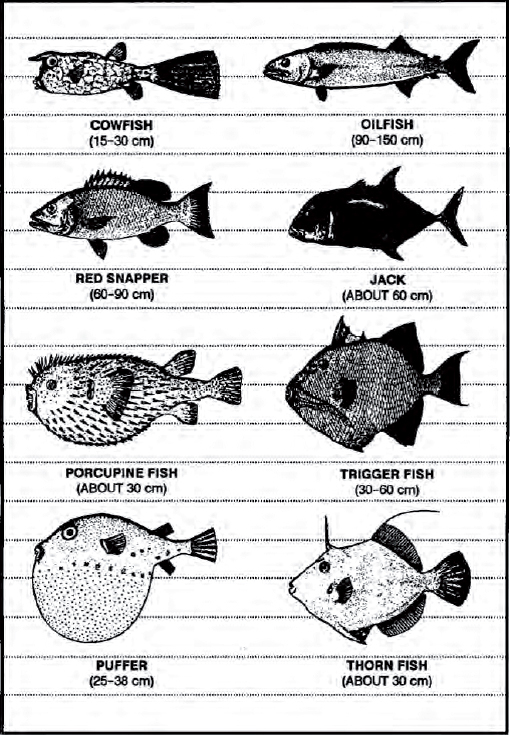
Figure 5-15: Fish with poisonous flesh
FISH WITH TOXIC FLESH
There are no simple rules to tell edible fish from those with poisonous flesh. The most common toxic fish are shown in Figure 5-15. All of these fish contain various types of poisonous substances or toxins in their flesh and are dangerous to eat. They have the following common characteristics:
• Most live in shallow water around reefs or lagoons.
• Many have boxy or round bodies with hard shell-like skins covered with bony plates or spines. They have small parrotlike mouths, small gills, and small or absent belly fins. Their names suggest their shape.
Blowfish or puffer (Tetraodontidae species) are more tolerant of coldwater. You find them along tropical and temperate coasts worldwide, even in some of the rivers of Southeast Asia and Africa. Stout-bodied and round, many of these fish have short spines and can inflate themselves into a ball when alarmed or agitated. Their blood, liver, and gonads are so toxic that as little as 28 milligrams (1 ounce) can be fatal. These fish vary in color and size, growing up to 75 centimeters in length.
The triggerfish (Balistidae species) occur in great variety, mostly in tropical seas. They are deep-bodied and compressed, resembling a seagoing pancake up to 60 centimeters in length, with large and sharp dorsal spines. Avoid them all, as many have poisonous flesh.
Although most people avoid them because of their ferocity, they occasionally eat barracuda (Sphyraena barracuda). These predators of mostly tropical seas can reach almost 1.5 meters in length and have attacked humans without provocation. They occasionally carry the poison ciguatera in their flesh, making them deadly if consumed.
In addition to the above fish and their characteristics, red snapper fish may carry ciguatera, a toxin that accumulates in the systems of fish that feed on tropical marine reefs.
Without specific local information, take the following precautions:
• Be very careful with fish taken from normally shallow lagoons with sandy or broken coral bottoms. Reef-feeding species predominate and some may be poisonous.
• Avoid poisonous fish on the leeward side of an island. This area of shallow water consists of patches of living corals mixed with open spaces and may extend seaward for some distance. Many different types of fish inhabit these shallow waters, some of which are poisonous.
• Do not eat fish caught in any area where the water is unnaturally discolored. This may be indicative of plankton that cause various types of toxicity in plankton-feeding fish.
• Try fishing on the windward side or in deep passages leading from the open sea to the lagoon, but be careful of currents and waves. Live coral reefs drop off sharply into deep water and form a dividing line between the suspected fish of the shallows and the desirable deepwater species. Deepwater fish are usually not poisonous. You can catch the various toxic fish even in deep water. Discard all suspected reef fish, whether caught on the ocean or the reef side.
CHAPTER 6
SURVIVAL USE OF PLANTS
After having solved the problems of finding water, shelter, and animal food, you will have to consider the use of plants you can eat. In a survival situation you should always be on the lookout for familiar wild foods and live off the land whenever possible.
You must not count on being able to go for days without food as some sources would suggest. Even in the most static survival situation, maintaining health through a complete and nutritious diet is essential to maintaining strength and peace of mind.